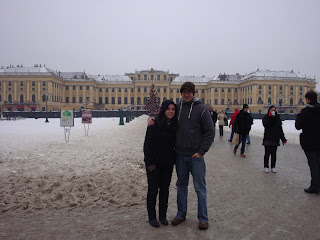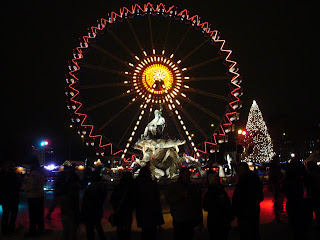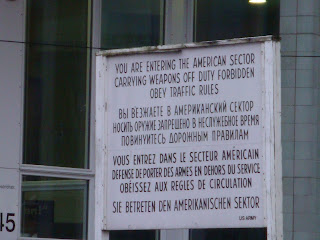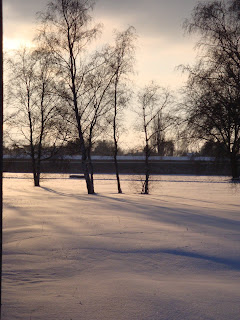We spent Christmas in Vienna and Berlin. On 12/21 we flew into Vienna and after checking into our hostel called Wombats we went to the Freud museum. It's set up in his home he lived in until 1938 when he fled the Nazis. We then visited the Museum Quarter and Hofburg Palace to see them at night.
 Taking notes in Freud's house
Taking notes in Freud's house  Freud's cigar box
Freud's cigar box  Museum Quarter
Museum Quarter  Hofburg Palace
Hofburg Palace  On 12/22 we first went to the St. Stephansdom Cathedral in the center of town. It was being restored so the front was covered in scaffolding. It's built on the site of a 12th century church. The roof was really interested. It's tiled with colors and on one side forms an eagle. We then went to watch the Anker (Ankeruhr) Clock at 12 pm when music plays for about 10 minutes. The figures are supposed to rotate around but none of them did. I think it's supposed to be slowly all day and faster at 12 pm while the music is playing.
On 12/22 we first went to the St. Stephansdom Cathedral in the center of town. It was being restored so the front was covered in scaffolding. It's built on the site of a 12th century church. The roof was really interested. It's tiled with colors and on one side forms an eagle. We then went to watch the Anker (Ankeruhr) Clock at 12 pm when music plays for about 10 minutes. The figures are supposed to rotate around but none of them did. I think it's supposed to be slowly all day and faster at 12 pm while the music is playing. We then went up to Danube Island. On one side of the island the water was almost completely frozen but on the other there wasn't any ice. It was very cold and snowy and is probably better to visit in the summer. We then took the underground to Schloss Schonbrunn Palace that is outside the city. The palace was my favorite part of Vienna. It is built in the baroque style by Leopold I to first be used as a hunting lodge. Empress Maria Theresa renovated and extended it in the 1700's. It has 2000 rooms including a chapel and theater. She was also the one to have it painted her favorite color yellow. Napoleon lived in the palace between 1805-09. The last Habsburg emperor was Charles I who abdicated in 1918 in the Blue Chinese Salon of the palace. Maria Theresa had 11 daughters, one was Marie Antoinette. Her grandson was Emperor Franz Joseph. He became king when he was only 18 years old and married Elizabeth (Sisi) who is famous for being very beautiful and had ankle length hair. Franz was emperor for 68 years and regularly worked 15 hours a day. He died of old age in 1916, we saw his bedroom and death bed. We also saw the rest of the imperial apartments, Sisi's dressing room, children's room that had portraits of Maria Theresa's daughters, the Grand Gallery, and the room where Mozart played his first royal concert at 6 years old. After he played he supposedly jumped on Maria Theresa's lap and kissed her. Edison put electricity into the palace in 1901. The rooms were all heated by ceramic covered stoves where coal would be put in the back from a secret hall. After walking through the palace we went into the gardens behind it. We saw a few fountains and climbed our way up to the Gloriette monument. By the time we got to the top of the hill it had gotten pretty dark so we went back to the hostel before going to a Christmas market. Rathaus is the city hall for Vienna and has one of the best Christmas markets set up in front of the building. Our dinner there was a hot dog called Kasekrainger and a warm drink called guhlwein.
 carriages waiting by the cathedral
carriages waiting by the cathedral
 River by Danube Island
River by Danube Island
 Schloss Schonbrunn Palace
Schloss Schonbrunn Palace
 ceramic heater
ceramic heater
 Mirror room Mozart played in
Mirror room Mozart played in
 Gardens behind the palace
Gardens behind the palace

 Rathaus Christmas market
Rathaus Christmas market
 12/23- After checking out of the hostel we took the underground to the central area and walked a loop around seeing many buildings. We passed the Parliament building and past the Rathaus again. We took the tram to see the Danube canal and then just continued walking around through Stadtpark. We finished the loop heading on the tram back to the Hofburg palace. Around this palace is also the Neueburg (3 museums) and the Spanish Riding School. We noticed a lot of statues of Hercules fighting men or creatures around the city especially near the Hofburg palace. We tried to eat at an Austrian food place for dinner but couldn't find anywhere open even though it was only about 4pm so we instead got some sandwiches and ate at the hostel before heading off to the airport. Overall Vienna was a pretty and clean city but wasn't one of our favorite cities. This may be because we left without knowing very much about the city like we have other places. Also the weather wasn't very nice, mostly cloudy. The Christmas markets were fun though.
12/23- After checking out of the hostel we took the underground to the central area and walked a loop around seeing many buildings. We passed the Parliament building and past the Rathaus again. We took the tram to see the Danube canal and then just continued walking around through Stadtpark. We finished the loop heading on the tram back to the Hofburg palace. Around this palace is also the Neueburg (3 museums) and the Spanish Riding School. We noticed a lot of statues of Hercules fighting men or creatures around the city especially near the Hofburg palace. We tried to eat at an Austrian food place for dinner but couldn't find anywhere open even though it was only about 4pm so we instead got some sandwiches and ate at the hostel before heading off to the airport. Overall Vienna was a pretty and clean city but wasn't one of our favorite cities. This may be because we left without knowing very much about the city like we have other places. Also the weather wasn't very nice, mostly cloudy. The Christmas markets were fun though.
 Parliament building
Parliament building
 Rathaus
Rathaus
 Hofburg palace
Hofburg palace

East Side Gallery



 church covered in scaffolding
church covered in scaffolding

 Once we got back to Berlin we only had a couple hours before our flight back to London so spent it in a Christmas market. We had yummy German sausage for dinner and watched a German Santa ride in his sled along a zipline across the market. Berlin was a great city with so many things to see and a very interesting history to learn about.
Once we got back to Berlin we only had a couple hours before our flight back to London so spent it in a Christmas market. We had yummy German sausage for dinner and watched a German Santa ride in his sled along a zipline across the market. Berlin was a great city with so many things to see and a very interesting history to learn about.
 carriages waiting by the cathedral
carriages waiting by the cathedral  River by Danube Island
River by Danube Island  Schloss Schonbrunn Palace
Schloss Schonbrunn Palace  ceramic heater
ceramic heater  Mirror room Mozart played in
Mirror room Mozart played in  Gardens behind the palace
Gardens behind the palace 
 Rathaus Christmas market
Rathaus Christmas market  12/23- After checking out of the hostel we took the underground to the central area and walked a loop around seeing many buildings. We passed the Parliament building and past the Rathaus again. We took the tram to see the Danube canal and then just continued walking around through Stadtpark. We finished the loop heading on the tram back to the Hofburg palace. Around this palace is also the Neueburg (3 museums) and the Spanish Riding School. We noticed a lot of statues of Hercules fighting men or creatures around the city especially near the Hofburg palace. We tried to eat at an Austrian food place for dinner but couldn't find anywhere open even though it was only about 4pm so we instead got some sandwiches and ate at the hostel before heading off to the airport. Overall Vienna was a pretty and clean city but wasn't one of our favorite cities. This may be because we left without knowing very much about the city like we have other places. Also the weather wasn't very nice, mostly cloudy. The Christmas markets were fun though.
12/23- After checking out of the hostel we took the underground to the central area and walked a loop around seeing many buildings. We passed the Parliament building and past the Rathaus again. We took the tram to see the Danube canal and then just continued walking around through Stadtpark. We finished the loop heading on the tram back to the Hofburg palace. Around this palace is also the Neueburg (3 museums) and the Spanish Riding School. We noticed a lot of statues of Hercules fighting men or creatures around the city especially near the Hofburg palace. We tried to eat at an Austrian food place for dinner but couldn't find anywhere open even though it was only about 4pm so we instead got some sandwiches and ate at the hostel before heading off to the airport. Overall Vienna was a pretty and clean city but wasn't one of our favorite cities. This may be because we left without knowing very much about the city like we have other places. Also the weather wasn't very nice, mostly cloudy. The Christmas markets were fun though.  Parliament building
Parliament building  Rathaus
Rathaus  Hofburg palace
Hofburg palace 12/24- We first went to do the Berlin free walking tour. We started by the Brandonburg Gate in Prazier Platz (Paris Square). In the square is the American Embassy and the Hotel Adlon where Michael Jackson hung his kid Blanket out the window. We also saw the Reichstag (Parliament). It was built in 1894 but at the time there was still a Kaiser (King) so was only a symbol of Democracy. It caught fire in 1933 and a Dutch was accused. He was crazy and would admit to anything. The fire however started in 5 different places and Hitler does not rebuild it. It was in West Berlin when the city was divided. It was rebuilt in 1990. We then walked through the gate to the Memorial of Murdered Jews of Europe. We passed over the location of Hitler's bunker where he and Eva Braun committed suicide. It is now only a parking lot for an apartment complex. Next stop was the Reichs Air Ministry Building. It was built in 1936 in the favorite architectural style of Hitler and the head office of Luftwaffe. It was of a few buildings that weren't destroyed during WWII (93% were). This was because before the war ended the city was divided up between the US, USSR, France, and the UK and the USSR knew they were going get this building so avoided bombing it. Under the USSR it became the Ministries of Ministries. A mural was painted on the side in 1952 showing the ideals of communism. In 1953 there was a protest by workers and the military was sent out and opened fire on the protesters outside the building killing 250 people. Behind the building we passed by some of the old Berlin wall. On the other side of this was an area called the Topography of Terror which was the location of the old SS and Gestapo offices. We then went through Check Point Charlie where foreigners, not Germans, could cross the walls. Next stop was Babel Platz (square) which had the State Opera House. It's been very unlucky because it first burnt down in 1843, then in WWII in 1941 it was bombed by the British, Hitler then rebuilt and it was bombed again in 1945, last it was rebuilt after the war but since it was in East Berlin East Germans built it so it was built poorly. The square also had the University's library. It's the University that Einstein had taught at before fleeing to the US. On May 10, 1933 the Nazi's burned 20,000 books from the library in Babel Platz. There was a memorial built into the ground that was 7ft x 7ft x 5ft deep with book shelves enough space for 20,000 books. It was a really interesting memorial but it was hard to see through the glass to see the bookshelves. Another memorial we saw was Neue Wache. It was the tomb for an unknown soldier from WWI in 1931. The Nazi's made it a memorial for victims of communism. It's now a memorial for victims of fascism and militarism with a statue of Geobbel's, a woman who lost a son in WWI and her husband and grandson in WWII. It's a statue of a woman holding her dying son. We went onto Museum Island which includes the Old Museum, New Museum, and a few others. Also on the island is the Berliner Dom Cathedral. The last Kaiser wanted it built to be similar to St. Paul's and St. Peter's. He thought he was an architect and designed the church himself. It's a mix of different styles. That was the end of the walking tour. By then it was dark so we headed back to the hostel and had dinner there. The restaurant in the hostel was sort of funny because it was Louisiana themed and had a mix of southern and German food.

12/25- Christmas morning we got up and first went by the East Side Gallery of the Berlin Wall. Next we went out to see a church that had been bombed and only one tower of the church had been left. Unfortunately it was covered in scaffolding. Then we went over to the Topography of Terror museum and spent the rest of the day there. After we went back to the hostel to meet up with a couple Australians from our room. It was a really nice German tasting dinner with excellent German beer.
East Side Gallery



 church covered in scaffolding
church covered in scaffolding 12/26- Our last day we spent on a tour of Sachsenhausen concentration camp. We took a train to the small town of Oranienburg where the camp was located. It was built by prisoners that would be living there and was open from July 1936 to April 1945. The USSR liberated it and found 3,000 prisoners there the other 35,000 living there were taken on a death march by the Nazis. 6,000 of them died in the march. The camp records had all been destroyed. The USSR used it as a prisoner camp from 1945 to 1950. It was opened as a memorial in 1961. The prisoners of the Nazis here built bricks, did leather work, dug trenches, and bomb disposal work in Berlin. The Allies bombed the brick factory. The style in which this camp was built was very efficient because it was in a triangle shape and from one spot you could see the whole camp. There was also SS training camps at Sachsenhausen. We entered the camp at Guard Tower A where the prisoners would have entered as well. The clock on the tower was stopped at 11:07 am the time of the camps liberation by the Soviets. On the gate in German was the phrase "Work will set you free." Just on the other side of the gate was where the roll call and assembly of the prisoners would take place. There are only a few of the barracks that held prisoners left. We went into one that held the Jewish prisoners. Half of it had been left as it was with a room full of bunk beds, another with tables, a room for toilets, and one for bathing. The other half was sort of a museum of photos and items found on the camp. We also saw a "T" shaped barrack that was surrounded by a stone wall. This one was for special/important prisoners. One of them included Stalin's son. The Nazi's tried to use his son to trade Stalin for 5 German Generals but Stalin said his son wasn't a ranking soldier so let him die. This barrack was filled with individual cells. We also went into what was the kitchen. The top floor was a museum of more artifacts which included some things the prisoners had hidden and a device used to strap prisoners down for getting whipped. At the back of the camp was Station Z where prisoners would have been killed. There were only the foundations of the building left and they were very weak and sinking in the ground. The prisoners knew that they would come in through Guard Tower A and would only leave through Station Z.

 Once we got back to Berlin we only had a couple hours before our flight back to London so spent it in a Christmas market. We had yummy German sausage for dinner and watched a German Santa ride in his sled along a zipline across the market. Berlin was a great city with so many things to see and a very interesting history to learn about.
Once we got back to Berlin we only had a couple hours before our flight back to London so spent it in a Christmas market. We had yummy German sausage for dinner and watched a German Santa ride in his sled along a zipline across the market. Berlin was a great city with so many things to see and a very interesting history to learn about. 













No comments:
Post a Comment